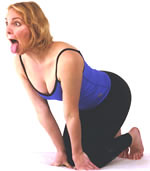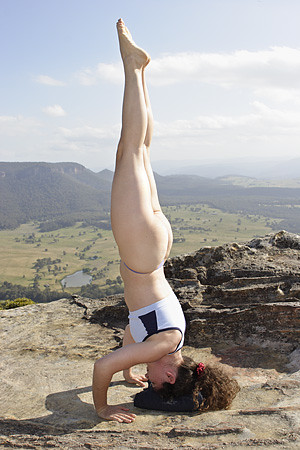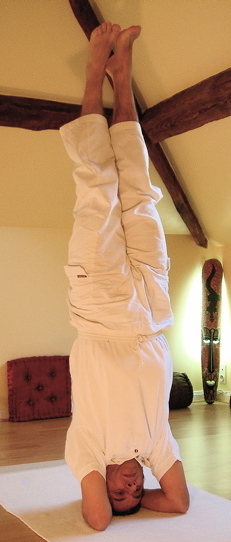 The word ‘Chakra’ means wheel. While doing this posture our body would look like a wheel, so it is called ‘Wheel Pose’, too. This is one of the poses of the yoga system known as Hatha Yoga. This helps in balancing the relationship between our mind and body. The posture given here is known as Supta Chakrasana, too.
The word ‘Chakra’ means wheel. While doing this posture our body would look like a wheel, so it is called ‘Wheel Pose’, too. This is one of the poses of the yoga system known as Hatha Yoga. This helps in balancing the relationship between our mind and body. The posture given here is known as Supta Chakrasana, too.Both men and women can do this posture. The women should avoid doing this pose during pregnancy. If a pregnant woman gets advice to practice certain yoga posture as an exercise, she should do it in the presence of a trained teacher only.
How to Do Wheel Pose, Chakrasana- Arrange your yoga mat properly and lye on your back. Bend you knees in a manner that both the feel remain flat on the floor. The distance between two feet should be as wide as your hip.
- Press the feet firmly on the floor and inhale slowly. Then try to lift the hip portion upward. While doing so you would lift your thighs and buttocks on the up side direction.
- Now use the hands. Put the palms firmly on floor keeping fingers facing your head. In order to lift your shoulder, just try to straighten your arms slowly but steadily. After the shoulders, your head also would be above the floor. When the legs and arms are fully stretched upward, the Wheel Pose is complete.
- Here you can hold yourself in Chakrasana until you feel pain. You can inhale and exhale, but try to keep breath inside for more time. It would give you strength to hold the posture for long.
- While coming back from this posture, do it slowly. Get you head down by bending elbow and then let the shoulders touch the floor. There after let the body rest in flat position or in corpse pose. It would help in decreasing fatigue.
Benefits of Doing Wheel Pose
 The Chakrasana, the wheel pose is one of the poses defined in Hatha Yoga system. Due to its posturing of our body, we can name it as Beck-Bend Pose. It would help in making our breathing system balanced. If we breathe following the natural rhythm, we would achieve many benefits or we can avoid many physical illness. The physical side of benefits of such backbend postures is multi-faced.
The Chakrasana, the wheel pose is one of the poses defined in Hatha Yoga system. Due to its posturing of our body, we can name it as Beck-Bend Pose. It would help in making our breathing system balanced. If we breathe following the natural rhythm, we would achieve many benefits or we can avoid many physical illness. The physical side of benefits of such backbend postures is multi-faced. Those who are suffering from Sciatica Pain, they can arrive benefit by doing wheel pose. But care must be taken if more pain is felt; in this case do this asana in the presence of a trained yoga instructor. A person feeling back pain would find it relieving a little bit. In the beginning this posture should be done in the presence of a trained teacher. You can join a good yoga classes where advanced yoga is practiced and taught.
If this posture is done with wearing proper yoga outfit, it would make you feeling more comfortable. A good yoga suit and a long yoga mat are advisable. While relaxing, you can use a soft yoga cushion. [First Image courtesy By Marcocarvalho [CC-BY-3.0], from Wikimedia Commons , Second Image courtesy By http://theholisticcare.com [null], from Wikimedia Commons]

 1:19 AM
1:19 AM
 abhi
abhi






